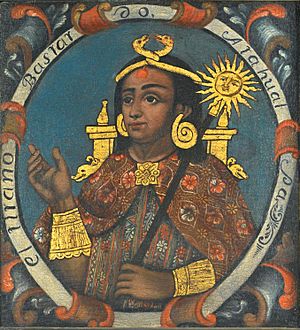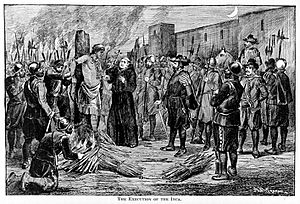Atahualpa facts for kids
Quick facts for kids Atahualpa |
|
|---|---|
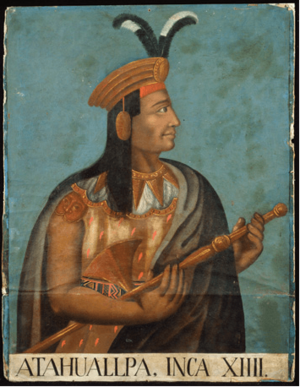
Portrait of Atahualpa by an unknown artist from the Cusco School. Currently located in the Ethnological Museum of Berlin, Germany
|
|
| Sapa Inca of the Inca Empire | |
| Reign | 1532–1533 |
| Self-installation | April 1532 |
| Predecessor | Huáscar |
| Successor | Túpac Huallpa (as puppet Sapa Inca of the Inca Empire) |
| Born | c. 1502 Discussed: Cuzco, Quito or Caranqui |
| Died | 26 July 1533 (aged 31) Cajamarca, Tawantinsuyu |
| Burial | 29 August 1533 Cajamarca, Tawantinsuyu |
| Consort | Coya Asarpay (queen), Cuxirimay Ocllo (secondary wife) |
| Quechua | Atawallpa |
| Dynasty | Hanan Qusqu |
| Father | Huayna Cápac – Inca Emperor |
| Mother | Discussed: Tocto Ocllo Coca Paccha Duchicela Túpac Palla |
Atahualpa (around 1502 – July 26–29, 1533) was the last powerful emperor of the Inca Empire. He ruled just before the Spanish arrived and took control.
Atahualpa was the son of Emperor Huayna Cápac. His father and his chosen successor, Ninan Cuyochi, died around 1525 from a smallpox disease. Atahualpa first accepted his half-brother Huáscar as the new emperor. Huáscar then made Atahualpa the governor of Quito in the northern part of the empire.
However, the peace between the brothers did not last. From 1529 to 1532, they fought for control in the Inca Civil War. Atahualpa's armies won and captured Huáscar.
Around the same time, Spanish explorers called conquistadors arrived. They were led by Francisco Pizarro. In November 1532, the Spanish captured Atahualpa in an ambush at Cajamarca. While he was a prisoner, Atahualpa offered a huge amount of gold and silver to be set free. He also arranged for Huáscar to be killed.
After getting the ransom, the Spanish accused Atahualpa of serious crimes. They put him on trial, and in July 1533, he was executed. After Atahualpa's death, other leaders claimed the title of emperor. But none of them had the same power as Atahualpa.
Contents
Who was Atahualpa?
His Name
The name Atahualpa comes from an old language called Puquina. This language was used by the Inca nobility. The name combines two Quechua words:
- Ata-w means "appointed" or "chosen."
- Wallpa means "diligent" or "courageous."
For a long time, people thought his name meant "happy rooster" or "bird of fortune." This was because the word wallpa also became the Quechua word for chicken. This idea came from stories that roosters crowed when Atahualpa was imprisoned.
Where He Was Born
There is some debate about where Atahualpa was born. The main ideas are that he was born in Cusco, the Inca capital, or in Quito or Caranqui in the north.
- Many Peruvian historians believe he was born in Cusco. They say his mother was an Inca princess. This idea comes from early Spanish writers who spoke directly with Inca nobles.
- Some Ecuadorian historians think he was born in Caranqui, near modern-day Ibarra in Ecuador. They suggest this was part of the Inca Empire's plan to expand.
- One idea, which many historians disagree with, is that his mother was a princess from a kingdom in Quito. This would have made him a legitimate son through an alliance.
Historians often disagree because of how they understood Inca traditions. The right to be emperor did not just depend on being the oldest son. It also depended on a leader's ability to command.
Growing Up as a Prince
Atahualpa spent his early years in Cusco with his father. When he was a teenager, he went through the Warachikuy. This was a special ceremony that marked his passage into adulthood.
When Atahualpa was about thirteen, some groups in the northern part of the empire rebelled. These were the Caranquis and the Cayambis. Atahualpa joined his father, Huayna Cápac, and his brother, Ninan Cuyuchi. They led the Inca army to the northern provinces, near Quito.
Atahualpa stayed in Quito with his father for over ten years. He helped put down rebellions and conquer new lands. He worked with skilled Inca generals like Chalcuchímac and Quizquiz. During this time, he learned how to govern and became known for his bravery in battles. People described Atahualpa as having "lively reasoning and great authority."
Before the Spanish Arrived
Inca emperors always worked to make their empire bigger. The 9th Inca emperor, Pachacuti, expanded the empire into northern Peru. His son, Tupac Inca Yupanqui, then conquered what is now Ecuador. Local tribes formed alliances to defend themselves against the Incas.
Around 1460, Tupac Inca Yupanqui easily took control of the Palta nation in southern Ecuador. But the Cañari people fought fiercely. The Incas were so impressed that they recruited the Cañari into their army after defeating them. Further north, the Incas faced strong resistance from the Quitus and Cañari.
After defeating them, Tupac Yupanqui sent settlers to the area of modern-day Quito. He left an Inca noble, Chalco Mayta, as governor.
Around 1520, tribes like the Quitos and Puruhá rebelled against Emperor Huayna Cápac. He personally led his army and defeated them. The northern tribes' alliance ended when Huayna Cápac married Paccha Duchicela. She was a queen of the Quitos, and this marriage helped secure Inca power in the region.
After Huayna Cápac died in 1525, Atahualpa was made governor of Quito by his brother, Huáscar.
The Inca Civil War
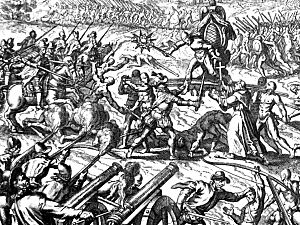
Huáscar saw Atahualpa as a threat to his power. But he did not remove him, respecting their father's wishes. For five years, there was an uneasy peace. Huáscar gained support from the Cañari, a strong group who disliked Atahualpa.
By 1529, the relationship between the brothers was very bad. Some stories say Huáscar's army ambushed Atahualpa in Tumebamba and captured him. Atahualpa supposedly escaped and lost an ear, which he then hid with a special headpiece. However, other historians doubt this capture story. They believe if Atahualpa had been caught, he would have been killed right away.
Atahualpa returned to Quito and built a large army. He attacked the Cañari in Tumebamba, destroying the city. He then went to Tumbes and planned to attack Puná Island. During this attack, Atahualpa hurt his leg. While he was recovering, the people of Puná attacked Tumbes, leaving it in ruins.
Huáscar's forces attacked Atahualpa's armies and defeated them in one battle. But Atahualpa's generals, Quizquiz and Calcuchimac, quickly regrouped. They counter-attacked and won a major victory.
Atahualpa's forces continued to win battles because of his generals' skill. Atahualpa slowly moved towards Cusco. While resting in Marcahuamachuco, he sent someone to ask a god for a prophecy. The god said Atahualpa's journey would end badly. Angry, Atahualpa destroyed the temple and killed the priest. It was around this time that he first heard about Francisco Pizarro and his Spanish expedition arriving.
In April 1532, Quizquiz and Chalcuchimac led Atahualpa's armies to victory in several battles. The Battle of Quipaipán was the final fight between the brothers. Atahualpa's generals defeated Huáscar's army, captured Huáscar, and took control of the capital, Cuzco. Atahualpa himself stayed in the city of Cajamarca, where he met the Spanish.
The Spanish Conquest
In January 1531, a Spanish group led by Francisco Pizarro landed on Puná Island. Pizarro had 169 men and 69 horses. The Spanish moved south and took over Tumbes. There, they learned about the civil war between Huáscar and Atahualpa.
About a year and a half later, in September 1532, Pizarro founded the city of San Miguel de Piura. He then marched towards the heart of the Inca Empire. He had 106 foot soldiers and 62 horsemen.
Atahualpa was in Cajamarca with his army of 80,000 troops. He heard about the strangers and sent an Inca noble to check them out. The noble stayed two days, studying the Spanish weapons and horses. Atahualpa decided that the 168 Spaniards were not a threat to his huge army. So, he invited them to Cajamarca to meet him, planning to capture them.
Pizarro and his men marched without trouble through difficult land. They arrived at Cajamarca on November 15, 1532.
Atahualpa and his army were camped on a hill outside Cajamarca. He was staying near some hot springs, and his soldiers were in tents around him. When Pizarro arrived, the town was mostly empty. The Spanish stayed in long buildings around the main square. Pizarro sent a group to Atahualpa, led by Hernando de Soto. Later, Pizarro's brother, Hernando Pizarro, brought more horsemen as backup.
The Spanish invited Atahualpa to visit Cajamarca to meet Pizarro. Atahualpa agreed to come the next day. Meanwhile, Pizarro set up a trap. Spanish soldiers and cavalry hid in the buildings around the square. Some musketeers and cannons were placed in a stone structure. The plan was to get Atahualpa to agree to Spanish rule. If that failed, they would attack by surprise.
The next day, Atahualpa left his camp at midday. A large group of men in special clothes walked ahead of him. As the procession moved slowly, Pizarro sent his brother Hernando to invite Atahualpa to enter Cajamarca before dark.
Atahualpa entered the town late in the afternoon. He was carried in a litter by eighty lords. Four other lords were also in litters or hammocks. With him were 5,000–6,000 men carrying small battle axes, slings, and pouches of stones.
The Inca found no Spanish soldiers in the plaza. They were all hidden inside the buildings. Only a Dominican friar named Vincente de Valverde came out with an interpreter.
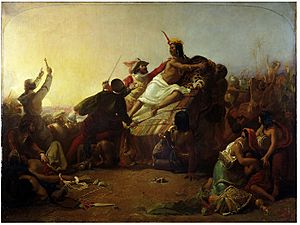
Valverde invited Atahualpa to talk and dine with Pizarro. Atahualpa instead demanded that the Spanish return everything they had taken. Valverde spoke about the Catholic religion and offered Atahualpa his prayer book. After looking at it briefly, Atahualpa threw it to the ground. Valverde quickly went back to Pizarro, telling the Spanish to attack.
At that moment, Pizarro gave the signal. The Spanish soldiers and cavalry rushed out of their hiding places. They charged the unsuspecting Inca group, killing many. The rest fled in panic. Pizarro led the attack on Atahualpa. He captured him only after killing all those carrying his litter and overturning it. Not a single Spanish soldier was killed.
Capture and Execution
On November 17, the Spanish searched the Inca army camp. They found great treasures of gold, silver, and emeralds. Seeing how much the Spanish wanted precious metals, Atahualpa made an offer. He promised to fill a large room (about 22 feet long, 17 feet wide, and 8 feet high) once with gold and twice with silver within two months. People often think Atahualpa offered this to get his freedom. However, some historians say he did it to save his life. Early writers do not mention the Spanish promising to free him after the metals were delivered.
After several months, the Spanish worried about an attack from Inca general Rumiñawi. The Spanish were outnumbered and decided Atahualpa was too risky to keep alive. Pizarro held a quick trial. Atahualpa was found guilty of rebelling against the Spanish, practicing his religion, and killing his brother Huáscar.
Friar Vincente de Valverde, who had given Atahualpa the prayer book, convinced Atahualpa to be baptized into the Catholic faith before he died. He was given the Christian name Francisco Atahualpa, honoring Francisco Pizarro.
On the morning of his death, Atahualpa was asked about his birthplace. He said he was born in Caranqui, in what the Incas called the Kingdom of Quito. This place is now in Ecuador.
Atahualpa was executed on July 26, 1533. His body was given a Christian burial. After Atahualpa, his brother Túpac Huallpa became emperor. Later, another brother, Manco Inca, took the title.
Atahualpa's Legacy
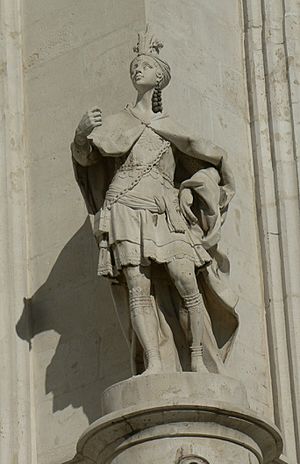
After Pizarro died, Atahualpa's favorite sister, Inés Yupanqui, married a Spanish knight and moved to Spain. Their daughter, Francisca Pizarro Yupanqui, later married her uncle, Hernando Pizarro. The Pizarro family line continued through them.
In Quito, Ecuador, the main football stadium is named Estadio Atahualpa in his honor.
On the front of the Royal Palace of Madrid in Spain, there is a statue of Emperor Atahualpa. It stands alongside a statue of the Aztec emperor Moctezuma II. These statues represent the kings of the ancient kingdoms that formed Spain.
The Inkarri Myth
A myth about Atahualpa's death and future resurrection became popular among native groups. This story, called Inkarri, spread far and wide. It tells of Atahualpa returning one day to restore the Inca Empire.
Where Are His Remains?
The exact burial place of Atahualpa is unknown. However, historian Tamara Estupiñán believes he was buried in modern-day Ecuador. She thinks he was buried there for safekeeping. The possible location is called Malqui-Machay, which means "mummy" in Quechua. Stone walls and underground water canals have been found there. More archaeological work is needed to confirm this idea.
See Also
 In Spanish: Atahualpa para niños
In Spanish: Atahualpa para niños
Images for kids


